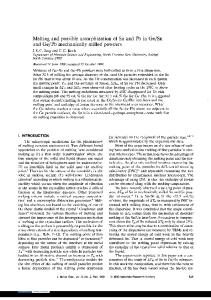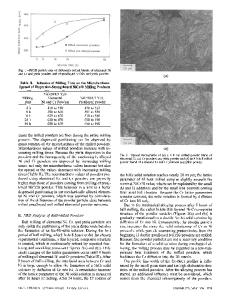Strengthening Mechanisms in Mechanically Milled Oxide-Dispersed Iron Powders
- PDF / 870,510 Bytes
- 10 Pages / 593.972 x 792 pts Page_size
- 59 Downloads / 324 Views
TRODUCTION
ONE method to produce bulk nanocrystalline materials is to use conventional powders of diameter of the order of several micrometers as starting materials, mill them, and finally consolidate and sinter them. However, during the sintering process, the crystallites in the milled powders grow in size to form grains, and in addition, new phases may also precipitate.[1,2] Thus, to understand the influence of milling on the material properties, it is necessary to examine the milled powders themselves before hot consolidation. Such a study on milled yttria dispersion-strengthened iron/steel powders is all the more important to understand the mechanism of the Y2O3 dispersoid formation and the influence of Ti addition on the dispersoids. In particular, it is not clear whether yttria particles dissolve in the iron/steel matrix and then reprecipitate combining with Ti to form complex oxides of nanometer size on exposure to high temperature[3,4] or if the yttria particles just become finer
R. VIJAY, Scientist ‘‘E’’, M. NAGINI, Research Scholar, J. JOARDAR, Scientist ‘‘E’’, M. RAMAKRISHNA, Scientist ‘‘C’’, A.V. REDDY, Technical Adviser, and G. SUNDARARAJAN, Director, are with the International Advanced Research Centre for Powder Metallurgy & New Materials (ARCI), Balapur, Hyderabad 500 005, India. Contact e-mail: [email protected] Manuscript submitted May 31, 2012. Article published online November 7, 2012 METALLURGICAL AND MATERIALS TRANSACTIONS A
and react with Ti to form nanometer-sized complex oxides during the milling process itself.[5,6] In either case, the strength of as- milled powders should critically depend on the crystallite size established during milling and the state (solid solution strengthening if Y2O3 dissolves or dispersion strengthening if finer Y2O3 particles are formed) in which Y2O3 exists. The hardness of the milled powder will be determined by the crystallite size strengthening as per Hall–Petch relationship[7,8] and solid solution strengthening due to Y in solution if the yttria dissolves in the Fe matrix during milling. In contrast, if the yttria particles just become finer during milling, the hardness value of the milled powder will be determined by the crystallite strengthening due to crystallite refinement and oxide dispersion strengthening due to the presence of complex oxides. The primary objective of the article is to find out the form in which Y2O3 exists and verify the validity of Hall–Petch relationship in nanocrystalline pure metal with and without the dispersion of ultrafine oxides. Toward this purpose, Fe, Fe-Y2O3, and Fe-Y2O3-Ti were studied. Pure iron was selected instead of steel to avoid the complicating effects due to C and other alloying elements. Yttria was chosen as the dispersoid in view of its stability and popularity in oxide dispersionstrengthened (ODS) steels, and Ti was added because of its well-established influence in reducing the dispersoid size. In this article, the term crystallite has been uniformly utilized to describe the structure of the milled powder. In the lite
Data Loading...











